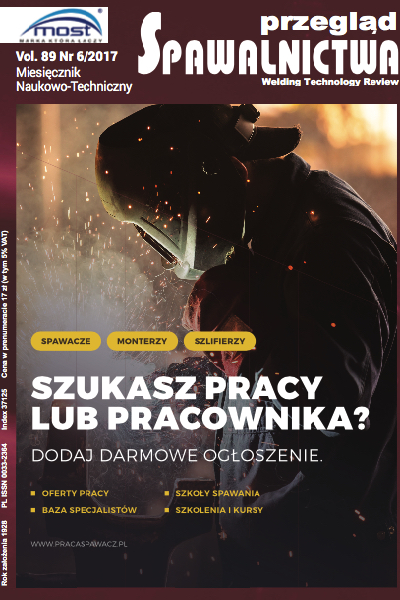Analytical-numerical analysis of laser welding of thin flat bars
Main Article Content
Abstract
In the paper an analytical-numerical model and the analysis of thermal phenomena, phase transformations and mechanical phenomena occur in laser welding of thin at bars were presented. To solve the heat transfer equation, the method of Greens function was used. To calculate the phase fractions and their kinetics the model based on the analysis of the continuous cooling diagram for the welding (CCT) is used. Phase fractions which occur during the continuous heating and cooling (austenite, pearlite or bainite) are described by Johnson-Mehl-Avrami (JMA) formula. To determine the formed martensite the modi ed Koistinen-Marburger (KM) equation is used. The stress and strain are determined by the solution of the equilibrium equations in the rate form using nite element method. In the model the thermal, structural, plastic strains and induced plasticity are taken into account. To calculate the plastic strains the Huber-Mises plasticity condition with isotropic hardening is used. Whereas to determine transformations induced plasticity the modi ed Leblond model is applied. The analysis of the phase content and stress state which occur during the butt welding of elements made of low carbon steel (S235) were performed. The calculations were carried out for the two cases of welding: a single laser beam and a double laser beam, where rst was a preheating source and the second the main welding source.
in polish
Analityczno-numeryczna analiza spawania laserowego płaskowników smukłych
W pracy przedstawiono model analityczno-numeryczny oraz analizę zjawisk cieplnych, przemian fazowych i zjawisk mechanicznych towarzyszących spawaniu techniką laserową smukłych elementów płaskich. Do rozwiązania zagadnienia przewodzenia ciepła zastosowano metodę funkcji Greena. Model szacowania udziału faz oraz ich kinetyki oparto na wykresie spawalniczym ciągłego chłodzenia (CTPc-S). Udziały faz metalurgicznych powstających podczas ciągłego nagrzewania i chłodzenia (austenit, perlit lub bainit) wyznaczano równaniem Johnsona-Mehla i Avramiego. Do wyznaczania tworzącego się martenzytu wykorzystano zmody kowane równanie Koistinena i Marburgera. Naprężenia i odkształcenia wyznaczono z rozwiązania metodą elementów skończonych równań równowagi w formie prędkościowej. Uwzględniono odkształcenia cieplne, strukturalne, plastyczne oraz odkształcenia indukowane przemianami fazowymi. Do wyznaczania odkształceń plastycznych zastosowano warunek plastyczności Hubera-Misesa ze wzmocnieniem izotropowym, natomiast odkształcenia plastyczne indukowane przemianami fazowymi obliczano formułą Leblonda. Dokonano analizy składu fazowego i naprężeń towarzyszących spawaniu doczołowemu elementów wykonanych z niskowęglowej spawalnej stali (S235). Analizę przeprowadzono dla dwóch wersji spawania: pojedynczą wiązką laserową oraz podwójnymi wiązkami, z których jedna została użyta do podgrzewania wstępnego, a druga do spawania.
Downloads
Article Details
Creative Commons CC BY 4.0 https://creativecommons.org/licenses/by/4.0/
Welding Technology Review (WTR) articles are published open access under a CC BY licence (Creative Commons Attribution 4.0 International licence). The CC BY licence is the most open licence available and considered the industry 'gold standard' for open access; it is also preferred by many funders. This licence allows readers to copy and redistribute the material in any medium or format, and to alter, transform, or build upon the material, including for commercial use, providing the original author is credited.
References
M. Melander: A computational and experimental investigation of induction and laser Hardening, Linkoping Studies in Science and Technology, Dissertation No 124, Linko- ping 1985.
Y.-N. Liu, E. Kannatey-Asibu: Laser beam welding with simultaneous Gaussian laser preheating. Journal of Heat Transfer, Trans. of the ASME, 115, (1993) pp.34-41.
A. Bokota, W. Piekarska: Modeling of residual stresses in laser welding. The Paton Welding Journal, no. 6 (2008) pp.19-25.
W. Piekarska, M. Kubiak, Z. Saternus: Numerical modelling of thermal and structural strain in laser welding process, Archives of Metallurgy and Materials 57 (4) (2012) pp.1219-1227.
V.Ju. Haskin, S.Ju. Pavlovskij, V.P. Garascuk, V.D. Seljagin, E.I. Gonczarenko: Osobennost svarki tonkolistovych nizkouglerodistych stalej impulsnoperiodiceskim izluceniem CO2lazera. Avtom.Svarka 2001, 2, 42-45.
J. Winczek, E. Gawrońska: The Modeling of Heat Affected Zone (HAZ) in Submerged Arc Welding (SAW) Surfacing Steel Element, Metalurgija, 55(2):225-228, 2016.
Ð’.И. Махненко, Е.Ð. Великоиваненко, О.Ð’.и др. Махненко: ИÑÑледование влиÑÐ½Ð¸Ñ Ñ„Ð°Ð·Ð¾Ð²Ñ‹Ñ… превращений на оÑтаточные напрÑÐ¶ÐµÐ½Ð¸Ñ Ð¿Ñ€Ð¸ Ñварке кольцевых
J. Brózda, J. Pilarczyk, M. Zeman: Spawalnicze wykresy przemian austenitu CTPc-S, Wydawnictwo Śląsk, Katowice 1983.
M. Coret, A. Combescure: A mesomodel for the numerical simulation of the multiphasic behavior of materials under anisothermal loading (application to two low-carbon steels), International Journal of Mechanical Sciences, 44 (2002) pp.1947-1963.
S-H. Kang, Y.T. Im: Finite element investigation of multi-phase transformation within carburized carbon steel. Journal of Materials Processing Technology 183 (2007) pp.241-248.
O.C. Zienkiewicz, R.L. Taylor: The nite element method, Butterworth-Heinemann, Fifth edition, vol. 1,2,3, 2000.
L. Taleb, N. Cavallo, F. Waeckel: Experimental analysis of transformation plasticity, International Journal of Plasticity, 17 (2001) pp.1-20.
L. Taleb, F. Sidoroff: A micromechanical modelling of the Greenwood-Johnson mechanism in transformation induced plasticity, International Journal of Plasticity, 19 (2003) pp.1821-1842.
